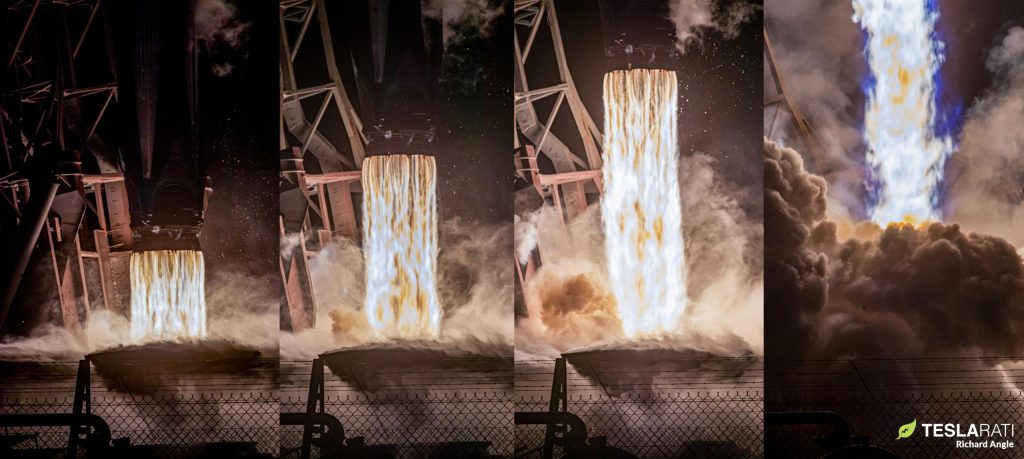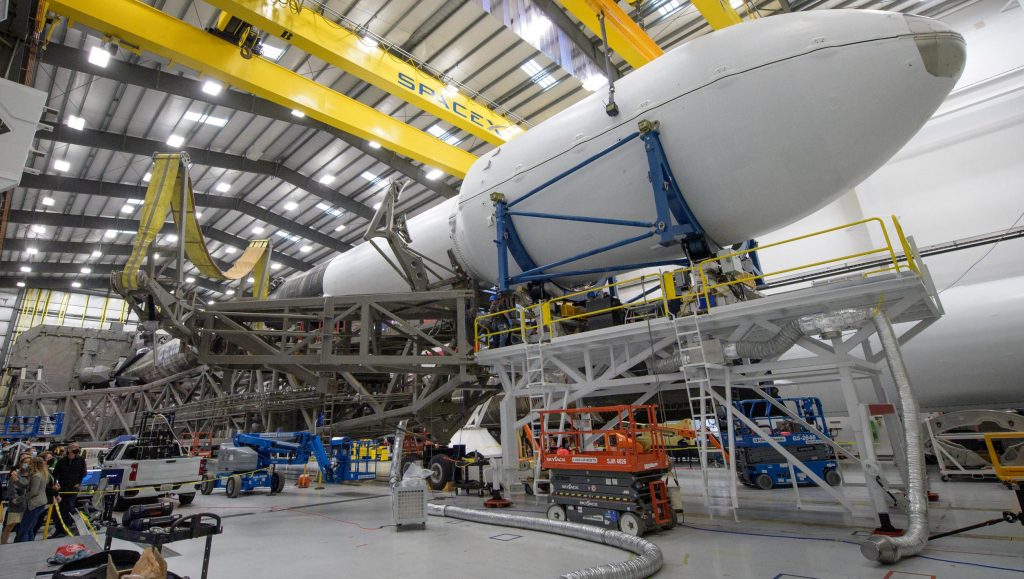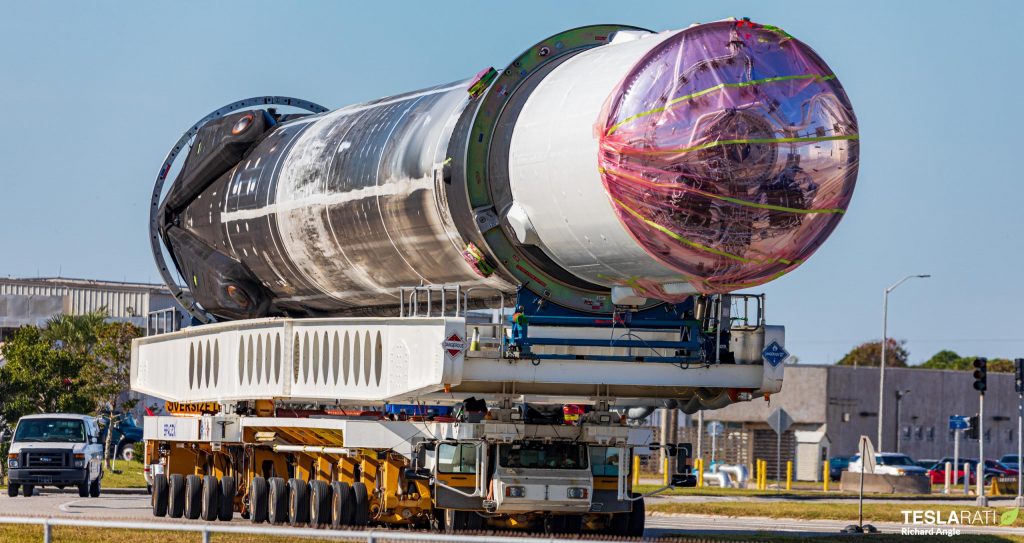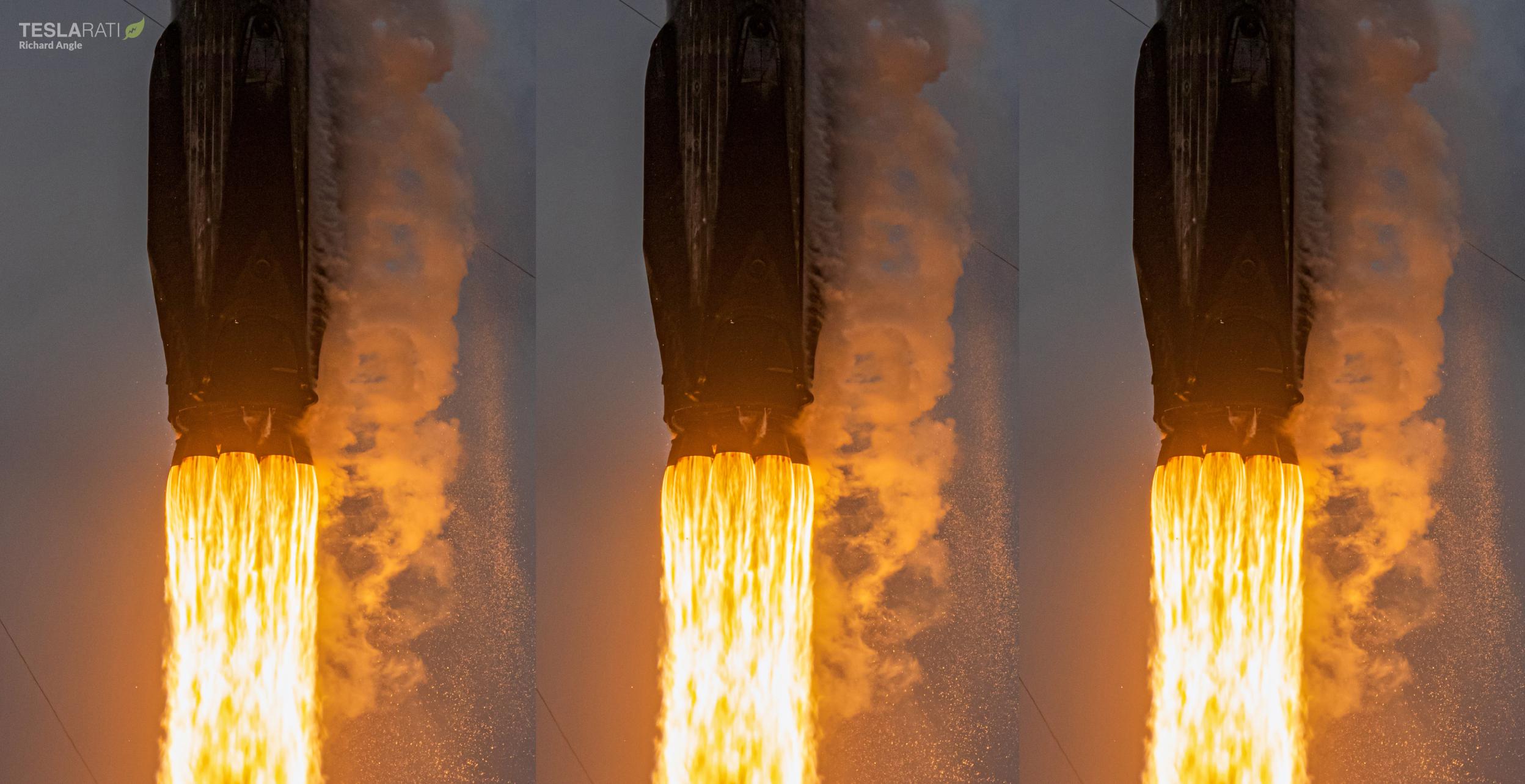Update #2: SpaceX has successfully delivered Starlink 4-4 – batch of 52 new satellites – to low Earth orbit (LEO), completing the first of three back-to-back Falcon 9 launches scheduled less than three days apart.
Starlink 4-4 marks the 98th successful Falcon landing, the first time SpaceX has performed a non-polar Starlink launch from its West Coast pad, and the first time a Falcon 9 booster has completed 11 orbital-class launches and spaceflights. Up next, SpaceX is scheduled to launch Turkey’s Turksat 5B geostationary communications satellite out of its Cape Canaveral, Florida LC-40 pad. Falcon 9 could lift off as early as 10:58 pm EDT, Saturday, December 18th (03:58 UTC 19 Dec) – just 15 hours after Starlink 4-4. Set in September 2021, SpaceX’s current record is two launches in ~44 hours.
Update: SpaceX’s second dedicated West Coast Starlink launch has slipped to no earlier than (NET) 1:24 am PDT (09:24 UTC) on Saturday, December 18th. Headed to an orbit unusual for a Vandenberg Space Force Base launch, Starlink 4-4 could now lift off just 18 hours before a different SpaceX mission – Turksat 5B – lifts off from the opposite side of the country.
Barring delays to Cargo Dragon’s CRS-24 space station resupply mission, which remains scheduled for 5:06 am EDT on December 21st, that means that SpaceX is now on track to launch three Falcon 9 rockets in three days (less than 73 hours).
SpaceX appears to be on track to round out a record-breaking year with three Falcon 9 launches in four days.
With the diverse trio of missions, SpaceX will orbit another batch of laser-linked Starlink satellites, deliver a large communications satellite to geostationary transfer orbit (GTO), send a Dragon to space for sixth time this year, and break at least two company records. The first mission, known as Starlink 2-3, could occur as early as the morning of December 17th, kicking off an incredibly busy period of launches – and not just for SpaceX.

Starlink 2-3
Referring to the fact that the mission will be the third launch for the second distinct group or ‘shell’ of Starlink satellites, Starlink 2-3 will actually be the second dedicated launch to a semi-polar orbit, leapfrogging Starlink 2-2 for unknown reasons after Starlink 2-1’s successful September launch. Originally scheduled to launch in mid-October, SpaceX was forced to stand down just a few days before liftoff for unknown reasons and at least a week or two of delays soon put Starlink 2-3 at risk of clashing with the company’s upcoming NASA DART launch, which unsurprisingly took precedence. SpaceX successfully launched the Double Asteroid Redirection Test (DART) mission on November 24th.
Late on December 13th, tugboat Scorpius likely departed Port of Long Beach with SpaceX drone ship Of Course I Still Love You (OCISLY) in tow – a fairly airtight confirmation that a SpaceX launch is just a handful of days away. Based on safety Notices to Airmen and Mariners (NOTAMs/NOTMARs), Starlink 2-3 is scheduled to launch sometime between 12am and 6am PDT (UTC-8) on Friday, December 17th. If accurate and SpaceX stays on schedule, Falcon 9 could lift off from the company’s Vandenberg SLC-4E launch pad with Starlink 2-3 in tow just 22 days after a different Falcon 9 rocket launched DART – smashing the pad’s current 36-day turnaround record by almost 40%.

Aside from drastically increasing the maximum theoretical launch cadence SpaceX’s West Coast pad is capable of supporting, Starlink 2-3 is also expected – as it was in October – to fly on Falcon 9 booster B1051, potentially making the mission the first time a liquid rocket booster has completed eleven orbital-class launches. B1051 debuted in March 2019, sending an uncrewed Crew Dragon on its way to orbit for the first time. Before SpaceX’s Starlink launch cadence fell off a cliff in the second half of 2021, B1051 completed its tenth launch on May 9th, 2021, averaging one launch every ~80 days over a two-year career. Starlink 2-3 will be B1051’s first launch in 7 months and eleventh launch in 33 months.
Turksat 5B
As early as 11:58 pm EDT (UTC-5) on Saturday, December 18th, another Falcon 9 rocket is scheduled to launch Turkey’s Turksat 5B geostationary communications satellite from SpaceX’s Cape Canaveral LC-40 pad. There’s a good chance that former Falcon Heavy booster B1052 – recently converted into a Falcon 9 after more than two years in storage – will be assigned to the mission, which is set to be SpaceX’s 30th orbital launch in 2021.

CRS-24 and more!
Finally, a different Falcon 9 (possibly B1062 or even a new booster entirely) is scheduled to launch a new Cargo Dragon 2 spacecraft on CRS-24 – potentially the company’s 23rd operational International Space Station (ISS) resupply run since October 2012. It will be Falcon 9’s sixth Dragon launch of 2021 – another record for SpaceX and the spacecraft. If the schedule holds, CRS-24 could lift off as early as 5:06 am EDT (UTC-5) on Tuesday, December 21st and would be SpaceX’s third Falcon 9 launch in roughly 100 hours (a little over four days). CRS-24 is expected to be SpaceX’s 31st and final launch of 2021, beating out the 26-launch record it set just last year.
However, the rest of the world isn’t quite finished. As early as the day after CRS-24, an Ariane 5 rocket is scheduled to launch the almost $10 billion, NASA-built James Webb Space Telescope (JWST). Decades in the making, JWST will be the single most expensive payload and the largest space telescope ever launched and is functionally irreplaceable and hard (but not impossible, if the political will is there) to repair, making it perhaps the most universally nerve-wracking uncrewed launch in the history of spaceflight.

Elon Musk
Elon Musk’s X will start using a Tesla-like software update strategy
The initiative seems designed to accelerate updates to the social media platform, while maintaining maximum transparency.

Elon Musk’s social media platform X will adopt a Tesla-esque approach to software updates for its algorithm.
The initiative seems designed to accelerate updates to the social media platform, while maintaining maximum transparency.
X’s updates to its updates
As per Musk in a post on X, the social media company will be making a new algorithm to determine what organic and advertising posts are recommended to users. These updates would then be repeated every four weeks.
“We will make the new 𝕏 algorithm, including all code used to determine what organic and advertising posts are recommended to users, open source in 7 days. This will be repeated every 4 weeks, with comprehensive developer notes, to help you understand what changed,” Musk wrote in his post.
The initiative somewhat mirrors Tesla’s over-the-air update model, where vehicle software is regularly refined and pushed to users with detailed release notes. This should allow users to better understand the details of X’s every update and foster a healthy feedback loop for the social media platform.
xAI and X
X, formerly Twitter, has been acquired by Elon Musk’s artificial intelligence startup, xAI last year. Since then, xAI has seen a rapid rise in valuation. Following the company’s the company’s upsized $20 billion Series E funding round, estimates now suggest that xAI is worth tens about $230 to $235 billion. That’s several times larger than Tesla when Elon Musk received his controversial 2018 CEO Performance Award.
As per xAI, the Series E funding round attracted a diverse group of investors, including Valor Equity Partners, Stepstone Group, Fidelity Management & Research Company, Qatar Investment Authority, MGX, and Baron Capital Group, among others. Strategic partners NVIDIA and Cisco Investments also continued support for building the world’s largest GPU clusters.
News
Tesla FSD Supervised wins MotorTrend’s Best Driver Assistance Award
The decision marks a notable reversal for the publication from prior years, with judges citing major real-world improvements that pushed Tesla’s latest FSD software ahead of every competing ADAS system.

Tesla’s Full Self-Driving (Supervised) system has been named the best driver-assistance technology on the market, earning top honors at the 2026 MotorTrend Best Tech Awards.
The decision marks a notable reversal for the publication from prior years, with judges citing major real-world improvements that pushed Tesla’s latest FSD software ahead of every competing ADAS system. And it wasn’t even close.
MotorTrend reverses course
MotorTrend awarded Tesla FSD (Supervised) its 2026 Best Tech Driver Assistance title after extensive testing of the latest v14 software. The publication acknowledged that it had previously criticized earlier versions of FSD for erratic behavior and near-miss incidents, ultimately favoring rivals such as GM’s Super Cruise in earlier evaluations.
According to MotorTrend, the newest iteration of FSD resolved many of those shortcomings. Testers said v14 showed far smoother behavior in complex urban scenarios, including unprotected left turns, traffic circles, emergency vehicles, and dense city streets. While the system still requires constant driver supervision, judges concluded that no other advanced driver-assistance system currently matches its breadth of capability.
Unlike rival systems that rely on combinations of cameras, radar, lidar, and mapped highways, Tesla’s FSD operates using a camera-only approach and is capable of driving on city streets, rural roads, and freeways. MotorTrend stated that pure utility, the ability to handle nearly all road types, ultimately separated FSD from competitors like Ford BlueCruise, GM Super Cruise, and BMW’s Highway Assistant.
High cost and high capability
MotorTrend also addressed FSD’s pricing, which remains significantly higher than rival systems. Tesla currently charges $8,000 for a one-time purchase or $99 per month for a subscription, compared with far lower upfront and subscription costs from other automakers. The publication noted that the premium is justified given FSD’s unmatched scope and continuous software evolution.
Safety remained a central focus of the evaluation. While testers reported collision-free operation over thousands of miles, they noted ongoing concerns around FSD’s configurable driving modes, including options that allow aggressive driving and speeds beyond posted limits. MotorTrend emphasized that, like all Level 2 systems, FSD still depends on a fully attentive human driver at all times.
Despite those caveats, the publication concluded that Tesla’s rapid software progress fundamentally reshaped the competitive landscape. For drivers seeking the most capable hands-on driver-assistance system available today, MotorTrend concluded Tesla FSD (Supervised) now stands alone at the top.
News
Elon Musk’s Grokipedia surges to 5.6M articles, almost 79% of English Wikipedia
The explosive growth marks a major milestone for the AI-powered online encyclopedia, which was launched by Elon Musk’s xAI just months ago.

Elon Musk’s Grokipedia has grown to an impressive 5,615,201 articles as of today, closing in on 79% of the English Wikipedia’s current total of 7,119,376 articles.
The explosive growth marks a major milestone for the AI-powered online encyclopedia, which was launched by Elon Musk’s xAI just months ago. Needless to say, it would only be a matter of time before Grokipedia exceeds English Wikipedia in sheer volume.
Grokipedia’s rapid growth
xAI’s vision for Grokipedia emphasizes neutrality, while Grok’s reasoning capabilities allow for fast drafting and fact-checking. When Elon Musk announced the initiative in late September 2025, he noted that Grokipedia would be an improvement to Wikipedia because it would be designed to avoid bias.
At the time, Musk noted that Grokipedia “is a necessary step towards the xAI goal of understanding the Universe.”
Grokipedia was launched in late October, and while xAI was careful to list it only as Version 0.1 at the time, the online encyclopedia immediately earned praise. Wikipedia co-founder Larry Sanger highlighted the project’s innovative approach, noting how it leverages AI to fill knowledge gaps and enable rapid updates. Netizens also observed how Grokipedia tends to present articles in a more objective manner compared to Wikipedia, which is edited by humans.
Elon Musk’s ambitious plans
With 5,615,201 total articles, Grokipedia has now grown to almost 79% of English Wikipedia’s article base. This is incredibly quick, though Grokipedia remains text-only for now. xAI, for its part, has now updated the online encyclopedia’s iteration to v0.2.
Elon Musk has shared bold ideas for Grokipedia, including sending a record of the entire knowledge base to space as part of xAI’s mission to preserve and expand human understanding. At some point, Musk stated that Grokipedia will be renamed to Encyclopedia Galactica, and it will be sent to the cosmos.
“When Grokipedia is good enough (long way to go), we will change the name to Encyclopedia Galactica. It will be an open source distillation of all knowledge, including audio, images and video. Join xAI to help build the sci-fi version of the Library of Alexandria!” Musk wrote, adding in a later post that “Copies will be etched in stone and sent to the Moon, Mars and beyond. This time, it will not be lost.”










